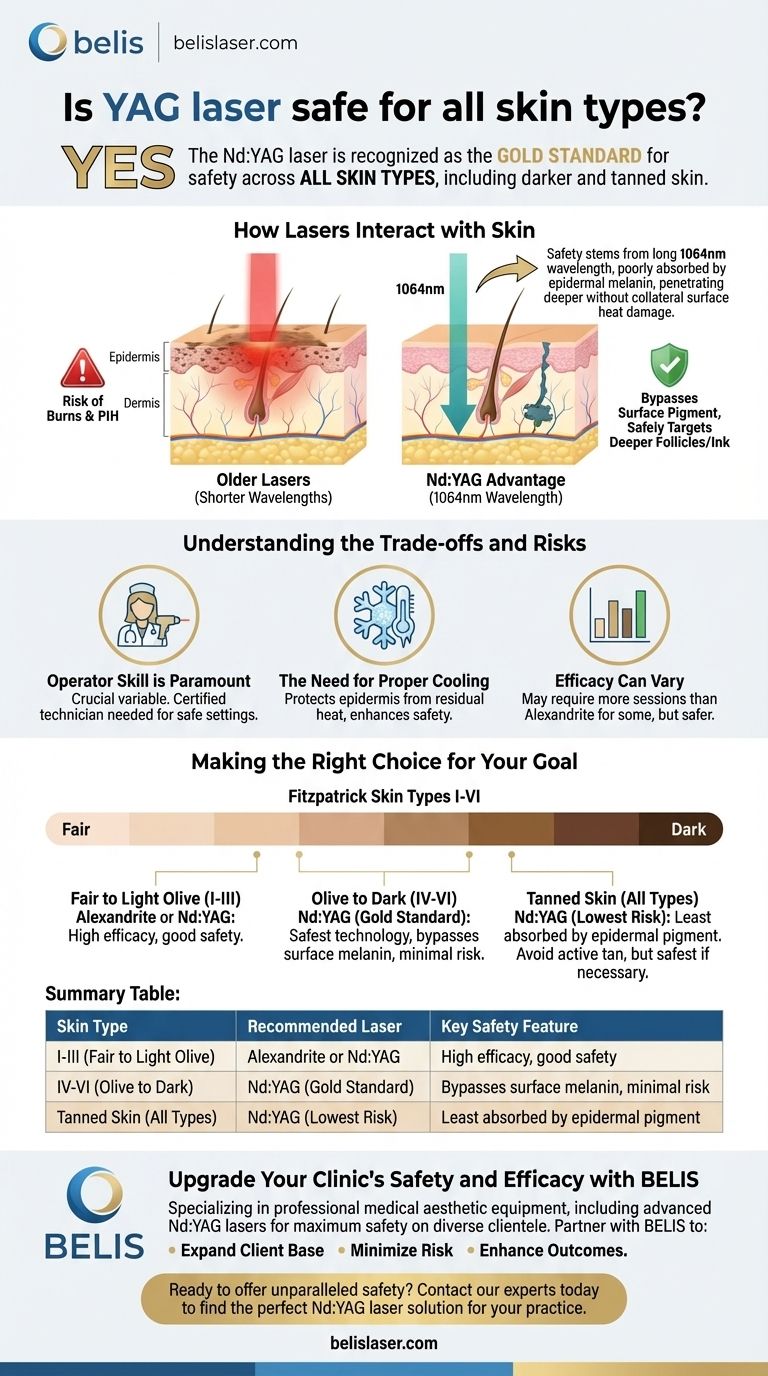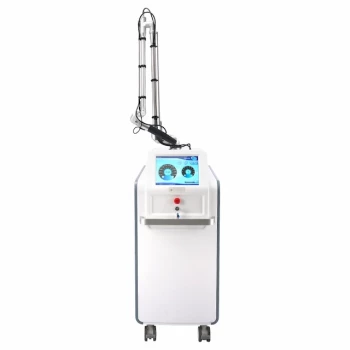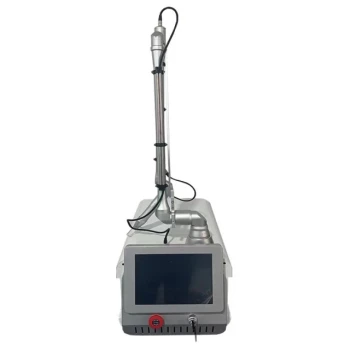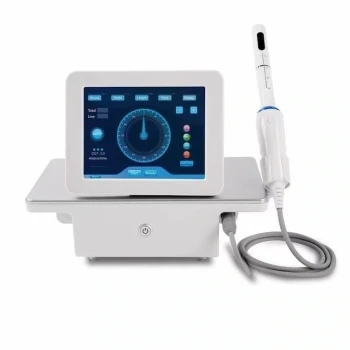Yes, the Nd:YAG laser is recognized as the gold standard for safety across all skin types, including darker and tanned skin. Unlike older laser technologies that pose a significant risk of burns or discoloration on skin rich in melanin, the Nd:YAG's specific properties allow it to safely bypass the surface layer of the skin and treat the underlying target.
The safety of the Nd:YAG laser stems from its long wavelength (1064nm), which is poorly absorbed by melanin in the epidermis. This allows it to penetrate deeper to its target—like a hair follicle or tattoo ink—without causing collateral heat damage to the surrounding surface skin, making it the safest option for darker skin tones.

How Lasers Interact with Skin
To understand why the Nd:YAG is safer, we must first understand the fundamental challenge lasers face with different skin tones.
The Role of Melanin
Lasers work by sending out a single wavelength of light that is absorbed by a specific target, known as a chromophore. In laser hair removal, the primary chromophore is the melanin (pigment) in the hair follicle.
The laser's energy is absorbed by the melanin, converting to heat and destroying the follicle.
The Challenge with Darker Skin
In individuals with darker skin (Fitzpatrick skin types IV-VI), the epidermis (the outermost layer of skin) also contains a high concentration of melanin.
Older lasers with shorter wavelengths cannot easily distinguish between the melanin in the hair and the melanin in the skin. This can cause the laser energy to be absorbed by the epidermis, leading to burns, blisters, and post-inflammatory hyperpigmentation (PIH), which is the darkening of the skin.
The Nd:YAG Advantage: Wavelength is Key
The Neodymium-doped Yttrium Aluminum Garnet (Nd:YAG) laser fundamentally solves this problem through its specific physical properties.
The 1064nm Wavelength
The Nd:YAG laser operates at a much longer wavelength of 1064 nanometers (nm). This is a critical distinction.
Think of it this way: shorter laser wavelengths are like a spotlight hitting a dark wall—they are absorbed at the surface. The long 1064nm wavelength is more like a radio wave that passes straight through the wall.
Bypassing Surface Pigment
Because of its long wavelength, the 1064nm light is significantly less absorbed by the melanin in the epidermis. It effectively bypasses the surface and travels deeper into the dermis.
This ensures the laser's energy is selectively delivered to the intended target—the melanin in a deep hair follicle or the dark ink of a tattoo—while leaving the surrounding skin tissue unharmed. This precision is what makes it exceptionally safe for skin of color.
Understanding the Trade-offs and Risks
While the Nd:YAG laser is the safest technology for darker skin, "safer" does not mean zero risk. The outcome is highly dependent on other critical factors.
Operator Skill is Paramount
The single most important variable in any laser treatment is the skill of the practitioner. An experienced, certified technician understands how to adjust the laser's settings (fluence and pulse duration) for your specific skin type and condition.
An improperly configured device or an inexperienced operator can cause damage with any laser, including an Nd:YAG.
The Need for Proper Cooling
Virtually all modern medical-grade Nd:YAG laser systems incorporate an advanced cooling mechanism. This can be a cryogen spray released just before the laser pulse or a chilled contact tip.
This cooling protects the epidermis from residual heat, further enhancing the safety and comfort of the treatment. A procedure performed without adequate cooling carries a higher risk.
Efficacy Can Vary
Because the Nd:YAG is less readily absorbed by melanin, it may require more sessions to achieve the same results as an Alexandrite laser on an ideal candidate (fair skin, dark hair). However, this is a necessary trade-off for ensuring the safety of the skin.
Making the Right Choice for Your Goal
Your skin type is the primary factor in determining the safest and most effective laser technology for you.
- If your primary focus is safety on olive, brown, or dark skin (Fitzpatrick IV-VI): The 1064nm Nd:YAG laser is the unequivocal gold standard and the safest technology available.
- If your primary focus is treatment on fair to light olive skin (Fitzpatrick I-III): You have more options, including Alexandrite (755nm) lasers, which can be highly effective, but the Nd:YAG remains an exceptionally safe choice.
- If your primary focus is treating tanned skin: You should always avoid laser treatments when you have an active tan, but the Nd:YAG laser presents the lowest risk if treatment is absolutely necessary.
Ultimately, the safety of your treatment depends on the right technology for your skin type being used by a highly qualified and experienced practitioner.
Summary Table:
| Skin Type (Fitzpatrick Scale) | Recommended Laser | Key Safety Feature |
|---|---|---|
| I-III (Fair to Light Olive) | Alexandrite or Nd:YAG | High efficacy, good safety |
| IV-VI (Olive to Dark) | Nd:YAG (Gold Standard) | Bypasses surface melanin, minimal risk of burns/PIH |
| Tanned Skin (All Types) | Nd:YAG (Lowest Risk) | Least absorbed by epidermal pigment |
Upgrade Your Clinic's Safety and Efficacy with BELIS
As a clinic or premium beauty salon specializing in diverse clientele, ensuring safe, effective treatments for all skin types is paramount. BELIS specializes in professional medical aesthetic equipment, including advanced Nd:YAG laser systems designed for maximum safety on darker and tanned skin.
Partner with BELIS to:
- Expand Your Client Base: Confidently treat clients of all ethnicities with the industry's safest laser technology.
- Minimize Risk: Leverage the gold-standard 1064nm wavelength to significantly reduce the chance of burns, blisters, and post-inflammatory hyperpigmentation (PIH).
- Enhance Treatment Outcomes: Our reliable, medical-grade equipment ensures consistent, superior results that build client trust and loyalty.
Ready to offer unparalleled safety and results? Contact our experts today to find the perfect Nd:YAG laser solution for your practice.
Visual Guide

Related Products
- Q Switch Nd Yag Laser Machine Tattoo Removal Nd Yag Machine
- Clinic Use IPL and SHR Hair Removal Machine with Nd Yag Laser Tattoo Removal
- Pico Picosecond Laser Machine for Tattoo Removal Picosure Pico Laser
- Pico Laser Tattoo Removal Machine Picosure Picosecond Laser Machine
- Diode Laser SHR Trilaser Hair Removal Machine for Clinic Use
People Also Ask
- What are the disadvantages of Q-switch laser? Managing Risks for Safe Treatment
- How does the Nd:YAG laser work? Unlocking Deep-Tissue Precision for Medical Aesthetics
- How much does a laser tattoo removal machine cost? Choose the Right Tech for Your Clinic
- How long does it take to recover from Nd:YAG laser treatment? A Timeline for Every Procedure
- What are the disadvantages of Q switching? Trade-offs in Pulse Control, Cost, and Beam Quality



















